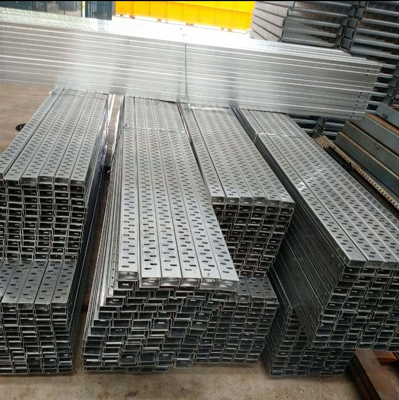Aluminum Perforated Cable Trays Manufacturer, Supplier, and Exporter in India
Superfab Inc offers premium Aluminum Perforated Cable Trays designed to meet the needs of modern cable management systems. Made from high-quality aluminum, these cable trays provide a lightweight yet durable solution for organizing and routing electrical, communication, and data cables in various commercial, industrial, and residential applications. The perforated design allows for superior ventilation and easy cable access, making them ideal for environments where airflow is crucial for maintaining system integrity and performance.
Product Features- Lightweight & High Strength
Constructed from high-grade aluminum, these cable trays offer a perfect balance of lightweight design and robust strength to support heavy-duty cables without compromising on performance. - Corrosion Resistance
Aluminum’s natural resistance to corrosion makes these trays ideal for use in humid, saline, or outdoor environments, ensuring longevity and low maintenance requirements. - Perforated Design
The perforated structure enhances ventilation, which helps in the dissipation of heat generated by electrical cables, improving overall system performance and reducing the risk of overheating. - Easy Installation
Aluminum Perforated Cable Trays are designed for quick and easy installation, with pre-punched holes that enable secure mounting, minimizing time and labor during setup. - Customizable Sizes and Configurations
Available in various sizes, lengths, and shapes, these trays can be customized to fit the unique requirements of your cable management system, ensuring a tailored solution for every project. - Sustainability
Aluminum is 100% recyclable, making these cable trays an environmentally friendly choice for sustainable cable management in all types of applications. - Aesthetic Appeal
The sleek finish of the aluminum trays provides a clean and professional look, perfect for areas where aesthetics matter without compromising functionality. - Flame Retardant
The flame-resistant properties of aluminum add an additional layer of safety, making these trays suitable for installations in high-risk environments.
Product Image
 Aluminium Perforated Cable Trays
Aluminium Perforated Cable Trays
- Superior Corrosion Resistance
Aluminum’s resistance to corrosion ensures the trays can withstand harsh environmental conditions such as high humidity, moisture, and exposure to chemicals, extending their life cycle. - Enhanced Ventilation
The perforated design ensures proper air circulation around the cables, preventing overheating and potential damage to sensitive electrical systems,which is especially important for high-power or high-heat cables. - Strength and Durability
Despite being lightweight, aluminum offers high strength-to-weight ratio, providing superior durability and support for even heavy cables, without adding unnecessary weight to the overall system. - Cost-Effective Solution
Aluminum Perforated Cable Trays are a cost-effective solution that offers long-term value by minimizing maintenance needs while providing a reliable and durable cable management system. - Environmental Benefits
As a 100% recyclable material, aluminum offers an eco-friendly solution that aligns with sustainability goals and environmental standards in construction and infrastructure. - Easy Access for Maintenance
The perforated holes make cable management more accessible for future upgrades, troubleshooting, or maintenance, allowing cables to be added, removed, or replaced without much difficulty.
Superfab Inc’s Aluminum Perforated Cable Trays are perfect for a wide range of applications across various industries:
- Industrial Plants and Manufacturing Facilities
Perfect for use in factories and industrial settings, these trays organize and route cables while allowing for maximum airflow and preventing heat buildup around critical systems. - Data Centers
Aluminum Perforated Cable Trays help manage the high volume of data cables in data centers, preventing cable overheating and ensuring seamless performance of IT infrastructure. - Commercial Buildings
These trays offer a clean, efficient cable management solution for commercial buildings such as offices, shopping malls, and retail spaces, maintaining a professional appearance - Telecommunications
Used to organize and secure network cables and fiber optics, these trays are ideal for telecom applications where both strength and ventilation are essential. - Outdoor Installations
Due to their corrosion resistance, aluminum trays are perfect for outdoor applications, such as cable management for street lighting, electrical systems, and communication lines. - Power Generation Plants
These trays are widely used in power plants and substations, where the demand for reliable and organized cable management systems is high, ensuring maximum operational efficiency.
- High-Quality Manufacturing
Superfab Inc ensures that each Aluminum Perforated Cable Trays is manufactured to the highest standards, ensuring durability, strength, and long-term performance. - Custom Solutions
We offer customization options to meet your specific needs, providing trays in various sizes, lengths, and configurations to suit your project requirements. - Cost-Effective & Reliable
Our aluminum trays offer an excellent combination of affordability, reliability, and long-lasting performance, reducing both installation and maintenance costs. - Cost-Effective & Reliable
Our aluminum trays offer an excellent combination of affordability, reliability, and long-lasting performance, reducing both installation and maintenance costs. - Sustainability Focus
As an environmentally conscious company, Superfab Inc provides 100% recyclable aluminum trays that contribute to a greener, more sustainable future. - Expert Support and Service
We offer expert technical support, ensuring the correct selection, installation, and use of Aluminum Perforated Cable Trays to meet your requirements. - Timely Delivery
Superfab Inc is committed to providing timely deliveries, ensuring that your projects stay on track without delays.
Superfab Inc’s Aluminum Perforated Cable Trays offer a reliable, durable, and efficient solution for cable management in both industrial and commercial settings. Their corrosion resistance, enhanced ventilation, and ease of installation make them the preferred choice for businesses looking to improve their cable management systems while maintaining high performance and safety standards.
Contact Superfab Inc today to learn more about our Aluminum Perforated Cable Trays and how we can help you with your cable management needs.
Also Check : Perforated Cable Trays | Aluminum Cable Trays | Aluminium Cable Tray Accessories
